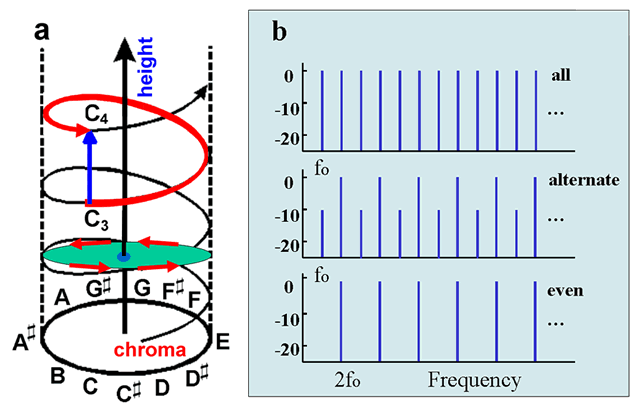
| Musicians recognize pitch as having two dimensions. On the keyboard, these are illustrated by the octave and the cycle of notes within the octave (C,D,E,F,G,A,B,C). In perception, these dimensions are referred to as pitch height and pitch chroma, respectively, and the notes of the musical keyboard are plotted along a helical line with one complete octave per circuit (see Figure above). Patterson (1990) pointed out that it is possible to make sounds that go up the side of the helix from a note to its octave without going round the chroma steps. The easiest way is to take a set of harmonics of some fundamental, f0, and progressively attenuate the odd harmonics without changing the fundamental. If you attenuate the odd harmonics in 3 dB steps, each step causes the perception to ‘go up’ noticeably (without changing the chroma) and in about 6 steps you arrive at the ‘same note’ in the next octave. |
| We have used notes on the surface of the helix to produce a ‘helix circle sound’ that goes ‘up’ the chroma dimension around the pitch helix forever but returns to its starting point each time around. The wave in the file HelixCircle.wav is circular. Drop it into your favourite sound player, put it into a loop and leave it on for a while at a moderate level. It goes endlessly up (with a short plateau every five notes), but somehow never leaves the original octave, because as it is going up in pitch chroma, we make a corresponding reduction in pitch height so that the sequence returns to the spot where it started after each cycle. This version of the helix circle goes up in chromatic steps like those on the keyboard, and to avoid promoting the perception that it drops back in pitch height at the octave, we have interrupted the sequence every five notes and repeated the fifth note twice. Since 5 does not divide into 12, it breaks up the perception of a traditional musical scale. |
| Jason Warren, Stefan Uppenkamp, Roy Patterson and Tim Griffiths have recently published an imaging paper in PNAS showing that there are distinct regions of activation in the brain for the processing of pitch chroma and pitch height. |
| Patterson, R.D. (1990) "The tone height of multi-harmonic sounds," Music Perception 8,203-214. |
| Warren, J.D., Uppenkamp, S., Patterson, R.D. and Griffiths, T.D. (2003). Separating pitch chroma and pitch height in the human brain. Proc. Nat. Acad. Sci. (in press). |
|
 |
|
|
 |

